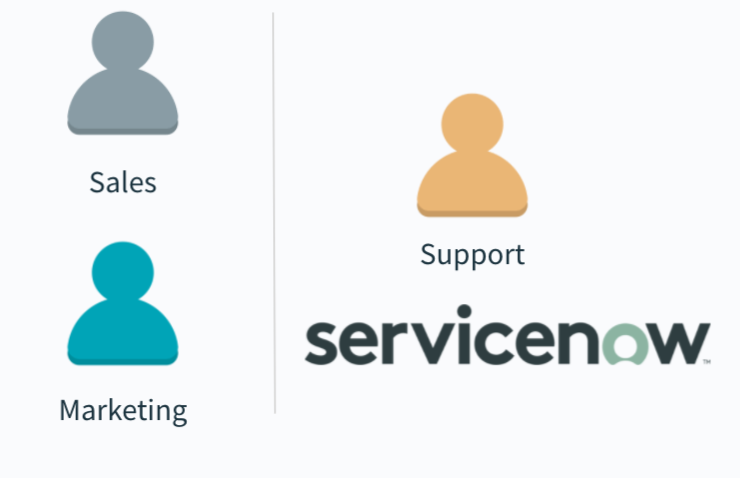It’s no secret that organizations of all shapes and sizes are adopting a growing number of apps.
For marketers, this can take the form of a new marketing automation platform, a digital asset management tool, and a project management tool; for your sales team, this can be a new CRM, a BI tool, and an e-signature platform—with the list going on as you look across functions.
As different teams adopt an ever-growing number of apps in the hopes of being more productive and successful, they’re often neglecting an important question: “How will our apps work across other teams and the apps they’re using?”
Without a clear answer, data silos inevitably take shape.
These data silos can harm employees’ decision-making abilities, as they don’t have all the data needed to perform effective data analysis. It can worsen a company’s culture, as teams may be misaligned as a result of working with different sets of information; and it can get in the way of employees taking timely actions, as they don’t have the real-time data they need to move quickly.
We’ll break down why, on a fundamental level, data silos exist, how they’re bad, and what your organization can do to prevent and solve for them (the solution is easier than you might think).
To get us started, let’s break down what it is.
Related: What is data integration? Here’s what you need to know
What is a data silo?
A data silo is when information gets locked into a specific app or set of apps, effectively preventing most employees from accessing it.
Let’s use an example to illustrate how it works.
All of the support tickets your team creates are kept in your ITSM tool (e.g. ServiceNow), and both the tickets and the information they contain don’t leave the tool.
Since employees in sales and marketing can’t access the ITSM app, they can’t find ticket-related insights.
As a result, sales and marketing can’t use the insights provided by the tickets to put clients into specific nurture sequences or to reach out at an individual level—both in the hopes of closing upsell/cross-sell opportunities.
Related: 3 examples of implementing ITSM integration
Why are data silos bad?
There are generally 4 reasons why data silos are harmful:
- Access to data gets delayed. An employee who requests access to the data might find that the steps in making the request are lengthy, and that the time it takes to process the request can get drawn out.
The latter can be particularly harmful when the request is time sensitive. For example, if a sales rep needs more information on an inbound lead, they need the information quickly, as delaying their response time can dramatically lower their chances of converting the lead.
- Employees experience difficulty in managing their time. Your team members are forced to spend significant chunks of their day searching for data and requesting access to it—when they can be performing more critical work, instead.
- Critical data may fly under the radar. Since many employees can’t access siloed data themselves, they might not be aware it exists. This prevents them from requesting access to it and ultimately having it at their disposal.
- Employees get discouraged from requesting data. As employees uncover the obstacles and delays in processing data requests, many might give up on making these requests in the future, especially when they’re time sensitive.
Why do data silos occur?
Now that you know why they’re bad, you might be wondering what the root causes of data silos are.
Though the answer can vary, it generally comes down to the technical complexities across your apps.
A given app might use a unique data structure that only a handful of specialists understand. As a result, these specialists are uniquely positioned to locate, access, and share the data.
For example, say someone in your transportation department is trying to give employees access to the corporate account for a ride-sharing app, like Uber. As part of the provisioning process, they need employees’ full names, titles, email addresses, etc.
Since the information likely lives in your HRIS, this employee would have to request access to it from specialists in the HR team who can find and share the data.
Note: In some cases, the process of acquiring data from applications is especially difficult. For instance, you might need to call complicated APIs in order to use the data. When this is the case, you’d rely on more technical resources from IT.
It’s worth noting that the situation above is relatively positive. The requester may also find themselves in a position where they don’t know who to make the request to, and if that were to happen, they wouldn’t have any way to retrieve the data.
How do you break down data silos?
The solution is fairly simple: Use a low-code/no-code platform that offers pre-built connectors for the apps you want to integrate and build workflows with.
With pre-built connectors, your team doesn’t need to understand the apps’ data models or engage with specialists who may take a while to process requests.
Instead, your team can use the app connectors to request the data they need and to build workflows across apps, data, and teams. And since the platform that provides the connectors can offer role-based security access controls, your team can decide which employees can access and use the data from a given connector.
Let’s go back to our earlier example to show you how this approach can work.
The team member who needs employees’ information can access it via the HRIS’ connector. More specifically, using the connector, they can build a workflow that collects all the required fields from certain employees (you can use rules to determine who’s eligible). As part of the workflow, the collected data could then go into a CSV file, which can automatically get shared with your partners at Uber.
Related: What is data mapping?
Learn how Workato can tear down and prevent any data silo
Workato, the leader in integration-led automation, offers a low-code/no-code platform that allows your team to integrate your SaaS applications, legacy systems, file servers, etc. and automate workflows across your apps, data, and teams securely with role-based access controls.
To help your team ideate and implement integrations and automations at scale, the platform provides 1,000+ pre-built connectors and hundreds of thousands of automation templates (“recipes”) that are ready-to-use, or can be customized as necessary.
To learn more about how Workato can help your team eliminate data silos as well as engage in enterprise-wide automation, you can schedule a demo with one of our experts.


